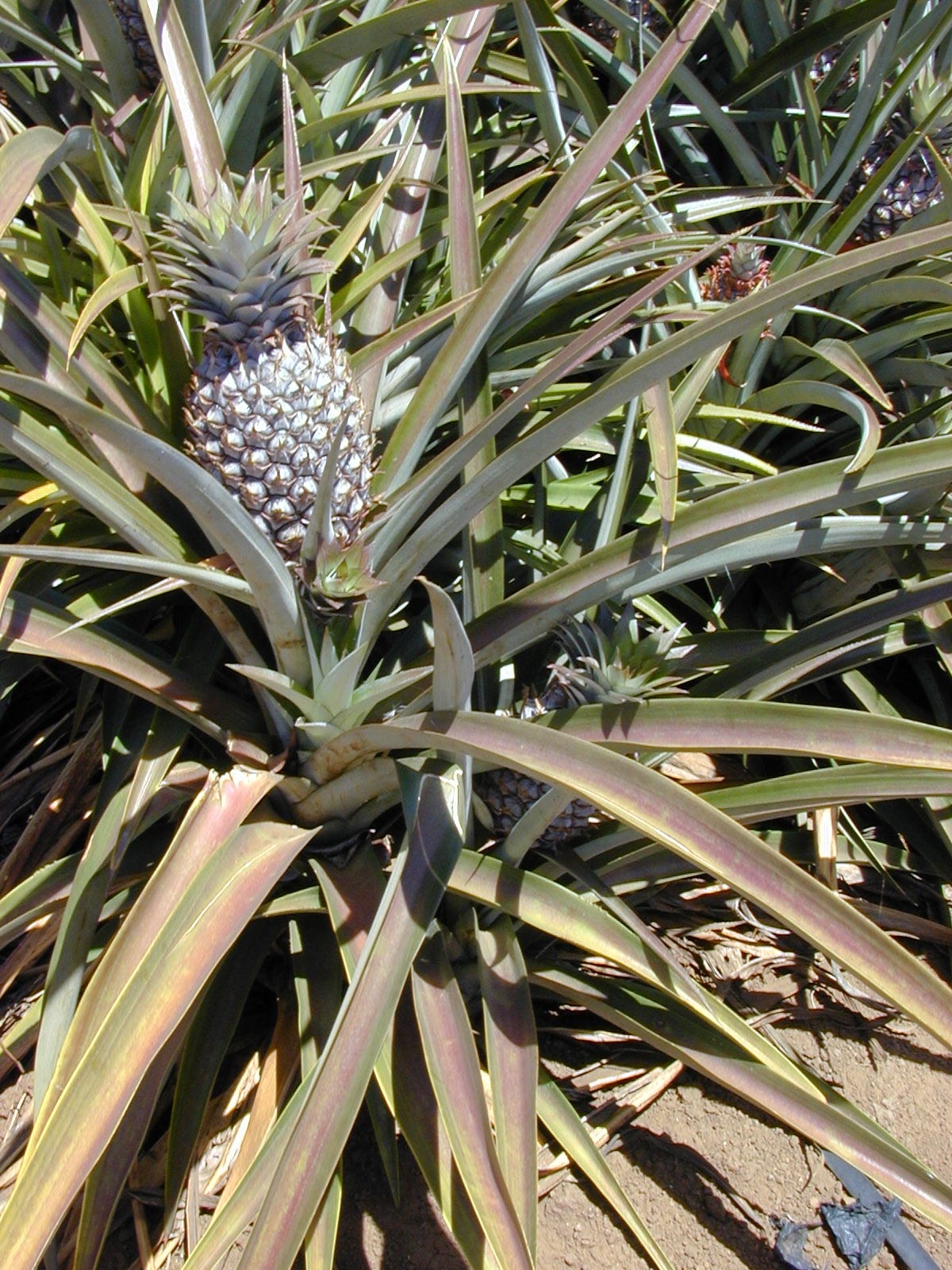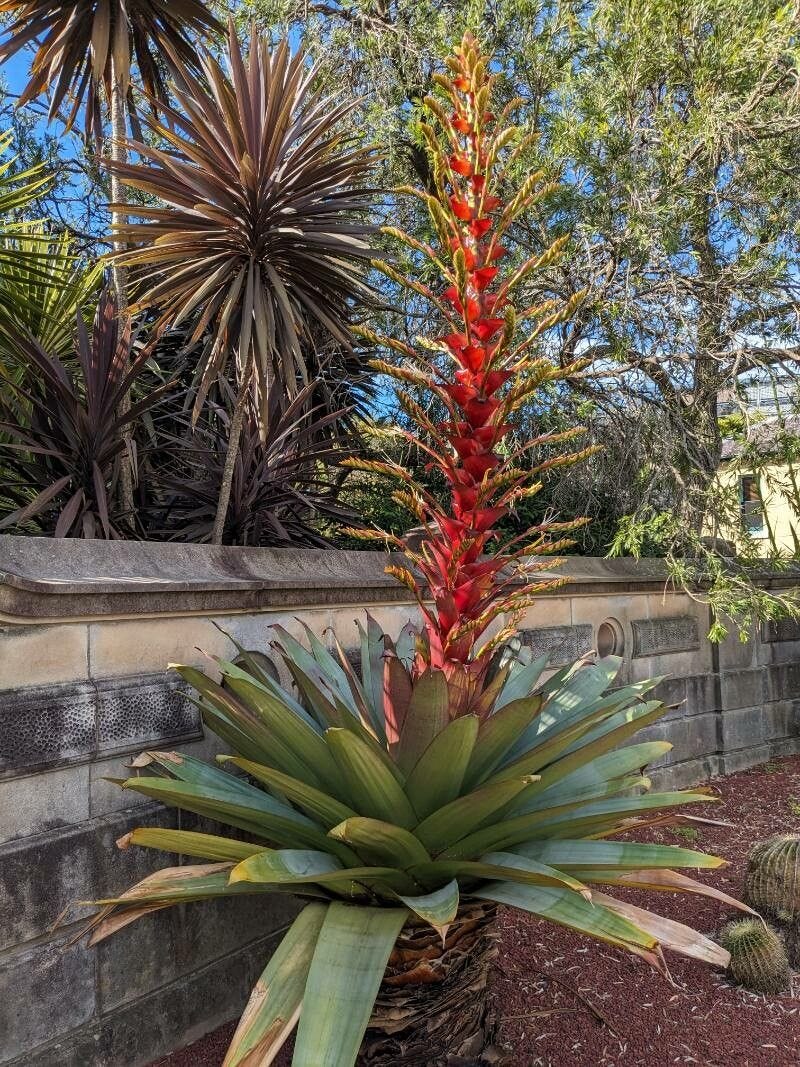ALSO KNOWN AS: Ananas comosus, nanas; Previously know as Ananas sativus, piña
How to know:
Layers of sharp leaves that grow out in a circle
A stem that plumps with pineapple
The entire plant can range from a metallic green to a green that blushes red at the corners.
Pineapple is more than a remnant of fruit salad buffets, or a sugary memory in the back of the throat with a touch of rum after too many hours in the sun. The pineapple has a long, beautiful history, with some very sinister lows. Most of us know the piña colada, a beach in a drink, but the fermented pineapple is a dim memory of its use as a medicine by the Carib peoples who used the fruit for food and medicine. It is named nanas, meaning “excellent fruit”, but this translation probably only touches the surface of a deeper meaning, something about excellence and fruit that are specific to the Caribbean culture that nurtured it.
On an Island in the Sun
Pineapple is native to the tropical and subtropical Americas. It is believed to be indigenous to the Paranà region in what is now Brazil. But it has been cultivated for centuries, if not thousands of years, among the indigenous populations on the Caribbean Islands, and has naturalized and adapted to those island climes.
The family Bromeliaceae includes about 50 genera each of which holds a host of species, all of which flourish entirely in the tropical hemisphere. Every one, that is, except for the Spanish moss, abundant in the American south.
A pineapple is like the very sharp version of a Gerber baby.
A neat number of 25 leaves grow in a circular nest before the fruit begins to develop like a sharp sun in the center of a bouquet of swords. Succulent, lanced leaves grow so sharp they could cut skin. The pineapple grows 30-40 leaves at full maturity. These leaves were used by the indigenous Carib and Tupi-Guarani peoples as fibers for garments, bows strings, and other textiles.
Pineapple can grow from almost any part of itself: slips and hapas, which grow on the side of the stem, suckers (also known as ratoons) that grow at the base of the parent plant, the crown, and the stem. However formidable the pineapple appears, and resilient it is in its growth, it is particular about its location. It can’t be too wet and it is prone to sunburns. So a range of sun, dappled light, and moist but aerated soil keeps it happy. Pineapples have a shallow root system. They grows between about two and four feet tall, though it has been known to reach taller. The sandy loam soils and well drained soils it loves remind us of the beach habitat where it has adapted.
Pineapple will not self pollinate, so they generally don’t have seeds unless there are many varieties close together. Those rare and tiny dark seeds line the shell where the soft ovaries are.
The geometrical interior of the fruit is called a sycarp, meaning they are a conglomeration of fruits all compacted into one.
Many bromeliads only bloom once. They aren’t flowery plants. A pineapple’s flower will emerge from a rosette of leaves, or bracts, as a purple head, not unlike a softened pineapple already. Once pollinated by the passing bat or hummingbird, the fruits will take four to five months to ripen.
Of Kings and Pineapples: A History of Violence
The brutality hidden behind the popularity of the pineapple is not far below the surface of European and American colonial opulence.
To the settlers, and slaveholders of the Caribbean islands, this plant represented power in the guise of hospitality. The emblem of the pineapple was placed on entrances to buildings because the early settlers understood the Carib people’s who had pineapple to be “kind”. This image continued to the colonies in the new United States where it can still be seen at the entrance of old colonial houses from Virginia to Boston.
The earliest written references to pineapple are by Christopher Columbus, Gonzalo Fernández de Oviedo y Valdés, and Sir Walter Raleigh. Painters, poets, and patrons were enamored by the fruit’s simultaneous strength and sweetness. With its high concentration of vitamin C, it would sustain sailors who were susceptible to scurvy for as long as the fruit would last on ships.
But the pineapple often rotted on the trip across the Atlantic Ocean making a scarcity market in Europe, which only added to its popularity.
Europeans saw the hard tuft on its top as no less than a crown and validation for empire. The rare pineapple that would make it to Eurasian shore could be sold for thousands of pounds. The pineapple grows in 68-86 degrees, so it would always prefer the warm belt of the equator. But Europeans could not get enough of this fruit. Its popularity was so avid that it did not take long for expensive greenhouses with intricate warming and moistening systems sustained and sequestered pineapples in Europe's cool climate.
The pineapple is now all over the world as a result of colonization. Swaths of the lands eaten by plantations. It was introduced to Zimbabwe, India, the Philippines, Guam, and Hawaii through the extensive, incessant reach of empire. In the frenzy for its majestic form and sweetness, the fruit was a symbol of wealth, as a centerpiece at dining tables. At times it would be rented for an evening, not to be eaten, but to be admired. Countless adorations cascaded upon this plant, “Scaly like an Artichoke at the first view, but more like to a cone of the Pine tree, which we call a pineapple for the forme … being so sweete in smell … tasting … as if Wine, Rosewater and Sugar were mixed together.” wrote in Theatrum botanicum a botanist before science was named.
Sweetness is what we seem to remember about the pineapple, but it has high amounts of vitamin C, magnesium, potassium, and iron, among other minerals. If you have eaten a lot of pineapple and felt a tingling sensation you know what it feels like to have the fruit bite back. That’s because pineapple has the enzyme bromelian, which are tiny crystals of calcium oxalate that the plant uses for self defense and effectively break down the protein in your mouth. It is an anti-inflammitory agent, and an aid in digestion.
myth for pineapple
Not to be confused with the massive Alcantarea imperialis, a plant that has a similar shape, though its fruit shines red at the top of a towering stem.
Or Tillandsia concolor, though they’re small and epiphytic (live in trees), they share the same shape.
Forager Friendly?
Yes. And, as a challenge for readers: You can plant pineapple from its crown… Try it!
Sources
https://www.britannica.com/plant/pineapple
https://plants.ces.ncsu.edu/plants/ananas-comosus/
https://gardeningsolutions.ifas.ufl.edu/plants/edibles/fruits/pineapples.html
https://www.atlasobscura.com/articles/history-housewarming-pineapple-symbol
https://blog.library.si.edu/blog/2021/01/28/the-prickly-meanings-of-the-pineapple/
https://www.biodiversitylibrary.org/bibliography/152383#/summary
https://hort.extension.wisc.edu/articles/bromeliads/
https://www.self.com/story/why-pineapple-burns-your-tongue







